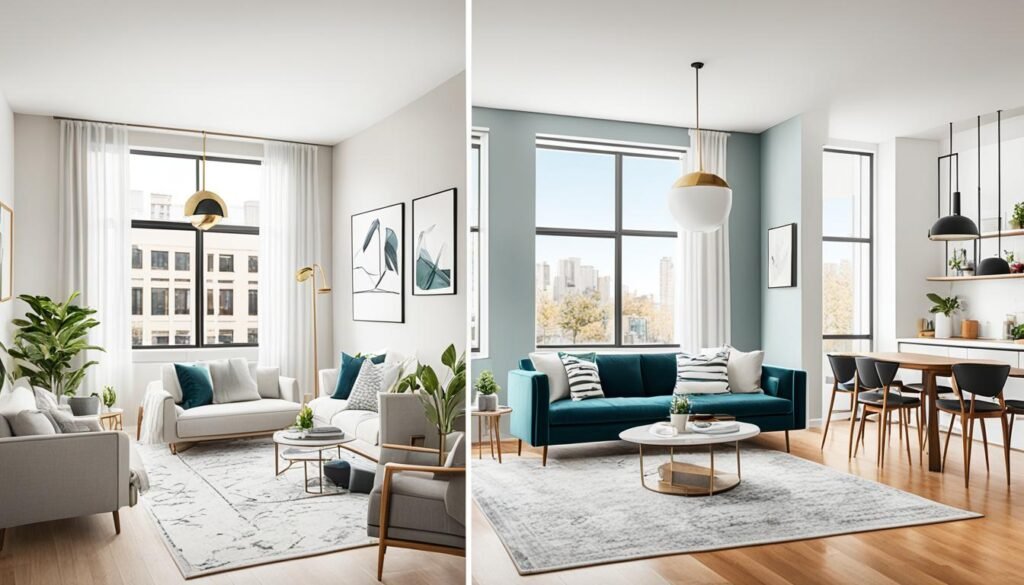Thinking about investing in a rental property? Choosing between furnished and unfurnished options is key to your success. This guide will help you understand the differences. It aims to aid in making a well-informed decision for your property management.
Buy-to-let mortgages allow for both furnished and unfurnished properties. Each choice has its own benefits and drawbacks. Knowing these can help you increase your rental income and find the right tenants.
Whether you’re experienced or new in the property market, it’s vital to consider the pros and cons of furnished versus unfurnished rentals. Let’s look at the factors that will influence your property management strategy and your investment returns.
What is the Difference Between Furnished and Unfurnished?
When looking for a place to rent, you’ll find two main choices: furnished or unfurnished lettings. It’s important to know the difference for both landlords and tenants.
Unfurnished Rentals Typically Include
Unfurnished rentals offer the essentials for daily life. These properties usually have:
- Kitchen fixtures (cooker, hob, sink)
- White goods (fridge/freezer)
- Bathroom fixtures
- Basic flooring
- Window coverings
Furnished Properties Generally Include
Furnished lettings give you more. You’ll get everything in unfurnished rentals plus:
- Sofas and chairs
- Dining furniture and tableware
- Bedroom furniture including beds
- Storage solutions

Choosing between furnished and unfurnished lettings depends on your needs. Families and those staying long-term often choose unfurnished properties. Students and young professionals might prefer furnished ones for their ease.
| Feature | Furnished Lettings | Unfurnished Lettings |
|---|---|---|
| Rent Premium | Up to 20% higher | Standard rate |
| Target Tenants | Students, Young Professionals | Families, Long-term Renters |
| Move-in Experience | Hassle-free | Requires own furniture |
| Inventory Process | More complex | Simpler |
Pros and cons of furnished vs unfurnished buy to lets
Choosing between furnished and unfurnished buy-to-let properties is a big decision. Landlords need to think about how it affects rental income and managing the property. Furnished properties usually get higher rents and attract young professionals and students. They can also lead to quicker rentals, which means more money for you.
Unfurnished properties might attract tenants for longer periods, cutting down on costs. They also mean less upkeep for landlords, as tenants bring their own furniture.
 Initial costs: Furnishing a property requires upfront investment
Initial costs: Furnishing a property requires upfront investment- Tenant preferences: Some prefer ready-to-move-in spaces, others want to personalise
- Target market: Students and young professionals often seek furnished flats
- Maintenance: Furnished properties need more upkeep
- Tax implications: Furnished lets may offer additional tax benefits
| Aspect | Furnished | Unfurnished |
|---|---|---|
| Rental speed | Generally faster | May take longer |
| Tenant type | Short-term, students | Long-term, families |
| Rental yield | Potentially higher | Typically lower |
| Maintenance | More frequent | Less frequent |
Your choice should match your investment goals, the type of tenants you want, and the local market. Thinking about these things will help you make the most of your rental income and manage your property better.
Which Option is Best for Landlords?
Choosing between furnished and unfurnished rentals can greatly affect your property management and rental income. Each choice suits different tenants and market needs.
Benefits of Letting a Furnished Property
Furnished properties usually get higher rents, especially in city areas. They draw in young people, students, and professionals who like the ease of moving in. This can mean faster tenant changes, helping you earn more.
Corporate tenants also prefer furnished places, offering steady rent and quick payments.
Benefits of Letting an Unfurnished Property
Unfurnished homes are popular with families looking to stay long-term. This leads to fewer tenant changes and less damage to your property. You’ll cut costs on furniture and upkeep, possibly lowering insurance too.
| Aspect | Furnished | Unfurnished |
|---|---|---|
| Rental Income | Higher | Lower |
| Tenant Type | Young professionals, students | Families, long-term renters |
| Tenant Turnover | Higher | Lower |
| Maintenance Costs | Higher | Lower |
Make your choice based on your property’s location, target audience, and what you prefer. Talk to local letting agents to get the latest market info in your area for the best management strategy.
Tenant Types for Furnished vs Unfurnished
Understanding what tenants want is key to a successful rental business. Different tenants have different needs for furnished or unfurnished properties.
Family renters usually want unfurnished homes because they already have their own furniture. They look for long-term rentals, giving landlords steady income for a while.
Young professionals and first-time renters might choose furnished places until they buy their own furniture. They often want short-term leases, especially near business hubs in cities.
| Tenant Type | Preferred Property | Typical Rental Duration |
|---|---|---|
| Families | Unfurnished | Long-term |
| Young Professionals | Furnished | Short to medium-term |
| Relocating Tenants | Furnished | Short-term |
| First-time Renters | Furnished | Short to medium-term |
Offering choices in furniture can draw in more renters, helping to rent out properties faster. This strategy lets landlords meet the needs of various tenants and increase their rental income.
Which Option is Best for Tenants?
Choosing between furnished and unfurnished rentals depends on what you want and need. Your choice affects both the cost and how happy you’ll be with your home.
Benefits of Renting a Furnished Property
Furnished properties are great for those who want convenience and don’t want to spend on furniture. They’re perfect for students, recent graduates, and young professionals looking for city centre living. These rentals are often taken quickly and come with the basics like appliances and furniture.
- Move-in ready, saving time and money on furnishings
- Ideal for short-term stays or frequent movers
- Often located in desirable urban areas
Benefits of Renting an Unfurnished Property
Unfurnished properties let you make your space your own. They’re best for those who plan to stay long-term and want to use their own furniture.
- Freedom to decorate and furnish to your taste
- Potentially lower rent compared to furnished options
- Fewer disputes over furniture damage at move-out
| Aspect | Furnished | Unfurnished |
|---|---|---|
| Initial costs | Lower | Higher |
| Personalisation | Limited | Extensive |
| Rental period | Short-term | Long-term |
| Move-in speed | Faster | Slower |
Think about your budget, how long you plan to stay, and what you like when picking between furnished and unfurnished. Each option has its pros, so choose what’s most important to you in your search for a rental.
Part-Furnished: A Third Option
When looking into rental property investment, knowing what tenants want is key. Part-furnished properties sit between fully furnished and unfurnished ones. They give landlords more control over how they manage their properties.
These rentals usually come with white goods like fridges and washing machines. You can also add more furniture if you want. This mix attracts many tenants, from young professionals to families. It lets them add their own touch while still having the basics.
For landlords, part-furnished properties are a smart choice. They cost less to set up than fully furnished ones but can earn you more rent than unfurnished ones. This mix can make your rental property investment more profitable.
| Property Type | Typical Inclusions | Target Tenants |
|---|---|---|
| Part-Furnished | White goods, optional furniture | Diverse range, including professionals and families |
| Fully Furnished | All white goods and basic furniture | Students, short-term tenants, corporate rentals |
| Unfurnished | Empty space, sometimes white goods | Long-term renters, families |
Offering part-furnished options lets you meet different tenant needs and might cut down on empty periods. It also opens up room for negotiation with tenants. This can make things better for both sides in the rental market.
Considerations for Furnished Lettings
Furnished lettings need extra care in property management. As a landlord, knowing key aspects is vital for your tenants’ safety and happiness.
Fire Safety and Regulations
Ensuring furniture meets fire safety standards is a key responsibility. Check that sofas, beds, and other items follow the rules. Keep records of your purchases and safety labels to prove you’re meeting standards.
Portable Appliance Testing (PAT)
PAT is essential for furnished lettings. Regularly test electrical items like kettles, toasters, and lamps. This makes sure they’re safe for your tenants and prevents accidents.
By focusing on these areas, you safeguard your property and your tenants. Regular checks and detailed records are smart moves. They ensure you’re legally compliant and give tenants confidence in their living space.
Tax Implications
Understanding the tax implications of furnished versus unfurnished rentals is key when managing your buy-to-let property. Your choice can greatly affect your rental income and how you manage your property.
Furnished properties usually have higher rents. In London, landlords can earn up to £9,120 a month, compared to £2,198 for average rentals. This big difference can change how much tax you pay and affect your buy-to-let mortgage decisions.
The ‘renewals basis’ lets landlords claim tax relief on new furniture costs for furnished properties. This can be a big plus when looking at long-term costs for managing your property.
| Property Type | Average Monthly Rent | Tax Deductible Items |
|---|---|---|
| Furnished | £9,120 | Furniture replacement costs |
| Unfurnished | £2,198 | Limited deductions |
| Part-furnished | Varies | Certain furnishings |
Part-furnished properties offer a middle ground. They give flexibility and potential tax deductions for certain furnishings. This might be a good option if you’re not sure about fully furnishing your rental property.
To make the most of your tax strategy for your buy-to-let investment, talking to a tax professional is a good idea. They can guide you through the complex world of property taxes. This ensures you’re using all available deductions while following UK tax laws.
Insurance Implications
Insurance is key when you invest in rental properties. Whether you choose to let a furnished or unfurnished property affects your insurance needs and costs.
Furnished properties mean you need extra contents insurance. This covers the furniture and appliances you offer, raising your insurance costs. Unfurnished properties, however, have lower insurance costs since there’s less to insure.
Being a landlord means more than just offering a place to live. You must get the right landlord insurance for your rental. This insurance covers risks like property damage, loss of rent, and liability claims.
| Insurance Aspect | Furnished Property | Unfurnished Property |
|---|---|---|
| Contents Insurance | Higher coverage needed | Lower coverage needed |
| Premium Costs | Generally higher | Generally lower |
| Liability Coverage | May need additional coverage | Standard coverage often sufficient |
Having the right insurance is crucial for managing properties well. It protects your investment and gives you peace of mind. This lets you focus on expanding your rental property portfolio.
Defining Furnished vs Unfurnished
Knowing the difference between furnished and unfurnished rental properties is key for good property management. Furnished properties come with all the needed furniture and appliances. They are perfect for young professionals, students, and those renting short-term who want convenience.
Unfurnished properties let tenants bring their own furniture. They are great for families and those renting long-term. Landlords should think about these points when deciding what to offer:
- Target tenant demographic
- Location of the property
- Potential rental yields
- Maintenance requirements
Make sure to have detailed inventories for both furnished and unfurnished properties. This helps set clear expectations and protects both landlords and tenants. Putting this info in the tenancy agreement makes things clear for everyone, making property management easier.
Tenant preferences change by location. In London, unfurnished rentals are more popular. In Manchester, furnished properties are often preferred. Knowing these differences helps you tailor your rental to the market, boosting your investment.
Conclusion
Deciding between furnished and unfurnished buy-to-let properties is key to your investment strategy. Each choice has its own benefits and challenges. These can greatly affect your success in the UK property market.
Furnished rentals often get higher prices, with long-term leases bringing in 15-20% more than unfurnished ones. Short-term lets can even see a 40-50% premium. This means more income and quicker tenant finding, making furnished properties a good choice for many landlords.
Unfurnished properties, however, have lower upfront costs and less upkeep. They draw in a wider tenant base, including those looking for long-term stays. Remember, your choice affects your mortgage options and investment plan.
Your decision should match your investment aims, target market, and local trends. Good property management is crucial, no matter your choice. By considering the pros and cons and getting expert advice, you can make the most of your rental property in the UK market.




